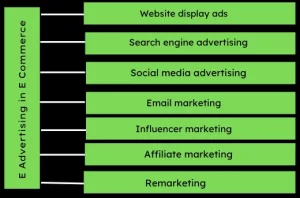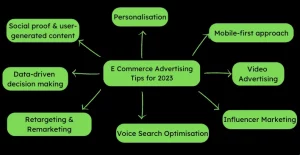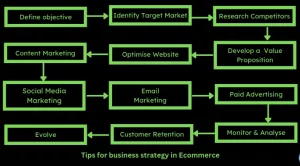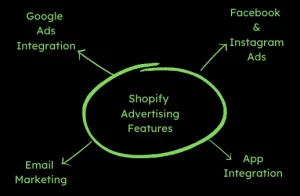Ecommerce Advertising: Tips & Strategies for 2023
You need customers that pay and that is the summary of your business! And, you are reading this blog because you have threads from ecommerce segment. If you are in a business you understand the relevance of ecommerce advertising to beat the competition.
Now, when online is a vast channel for reaching the target audience, having an advertising strategy is a must. Without an e commerce strategy, you cannot align sales with marketing goals.
2023 is the year of more challenges and AI-driven marketing strategies bringing in wide opportunities for the businesses to expand.
What is e-commerce marketing?
Ecommerce marketing, in the eloquent words of Bryan Kramer, can be described as the art and science of orchestrating a digital symphony to captivate, inspire, and entice online consumers. It encompasses a harmonious fusion of strategies, tactics, and technologies that harmonise the online shopping experience.
You can more successfully increase your income and draw in the correct clients with the aid of a targeted ecommerce marketing approach.
It might be challenging to know where to begin because there are so many different marketing tactics. This post will outline the steps involved in creating an e-commerce marketing plan and provide you with some initial inspiration.
Let us read further to know what is ecommerce marketing strategy and how it is different from e-commerce advertising?
What is an e-commerce marketing strategy?
Marketing strategy can be defined as a deliberate, customer-centric roadmap that guides businesses in creating remarkable experiences and nurturing enduring relationships with their target audience.
Preparing a marketing strategy requires a deep understanding of the customer’s journey, empathising with their pain points, and envisioning how to alleviate them through thoughtful engagement.
By adopting this customer-centric mindset, ecommerce businesses can transcend the noisy marketplace and become a trusted platform for shopping. Speaking from the perspective of ecommerce marketing, you can read about ecommerce marketing strategy.
Ecommerce marketing strategy refers to businesses’ comprehensive plans and tactics to promote and sell products or services online, aiming to maximise online sales, expand customer reach, and enhance overall profitability. It encompasses a range of strategic activities tailored specifically for the digital realm to attract, engage, and convert potential customers into loyal buyers.
And when you know the exact target audience, converting their interaction into sales using paid promotion is e-commerce advertising.
For example,

Your attention is drawn to this Sprint deal by the tall black skyscraper advertisement on a white background. It shows a phone, plan, and Hulu bundle for less than $35 per month.
Visual hierarchy serves its purpose underneath the business logo, which identifies Sprint at the top and is a recognised symbol with strong brand equity.
E advertising in e commerce
E advertising refers to online advertising that can promote the products beyond a limited area and makes it easy for global reach. It is the process of distributing sponsored advertisements to promote online product sales. The advertiser will pay for placement, impressions, clicks, etc.
E-advertising also plays a crucial role in the success of e-commerce businesses. It utilises various digital channels to promote products or services, attract potential customers, and drive sales.
Some key uses of e-advertising in e-commerce:

Website Display Ads:
E-commerce websites often display banner or text ads on their web pages or partner websites. These ads can be strategically placed to target specific audiences, and they help generate brand awareness, increase visibility, and direct traffic to the e-commerce site.
Search Engine Advertising:
E-commerce businesses can utilise platforms like Google Ads to display ads at the top of search engine results pages (SERPs). This allows them to reach potential customers actively searching for related products or services. Paid search ads can significantly increase website traffic and conversions.
Social Media Advertising:
Social media platforms like Facebook, Instagram, Twitter, and LinkedIn offer powerful advertising tools to target specific demographics, interests, and behaviours. E-commerce businesses can run highly targeted ad campaigns to reach their ideal customers, increase brand engagement, and drive website traffic.
Email Marketing:
E-commerce businesses often use email marketing to reach their existing customer base or potential customers who have shown interest. They can send personalised emails, newsletters, product updates, and promotional offers to encourage repeat purchases, cross-selling, and upselling. Email marketing is a cost-effective way to build customer loyalty and drive sales.
Influencer Marketing:
E-commerce businesses can collaborate with influential individuals or social media personalities (influencers) with a large and engaged following. These influencers can promote products or services through sponsored content, reviews, or endorsements, reaching a targeted audience and driving sales.
Affiliate Marketing:
E-commerce businesses can partner with affiliate marketers who promote their products or services on their websites, blogs, or social media platforms. Affiliates earn a commission for every sale or lead generated through their referral. This form of performance-based marketing can help e-commerce businesses expand their reach and increase sales.
Remarketing:
E-commerce businesses can use remarketing techniques to target users who have previously visited their website but did not purchase. By displaying targeted ads across various digital platforms, such as display networks or social media, e-commerce businesses can re-engage these users and encourage them to return and complete their purchases.
Difference between e commerce marketing and e commerce advertising
Let us read the difference between e commerce marketing and e commerce advertising:
| Aspects | E Commerce Marketing | E Commerce Advertising |
| Definition | A broad set of strategies and activities to promote and grow business online. | Specific tactics and campaigns focused on paid promotion and advertising |
| Scope | Includes activities throughout the customer journey awareness, consideration, conversion, and retention. | Primarily focus on generating awareness and driving traffic/ sales. |
| Objective | Build brand awareness, engage customers, drive traffic, foster customer loyalty. | Drive targeted traffic, increase visibility, and maximise conversions. |
| Strategies and Tools | Content marketing, SEO, email marketing, social media marketing, influencer marketing, customer retention strategies, etc. | Pay-per-click (PPC) advertising, social media ads, display ads, retargeting, affiliate marketing, sponsored content, etc. |
| Audience Reach | Reaching both existing and potential customers. | Reach the target audience to drive specific actions. |
| Cost | Mix of paid and organic depending on the scale of strategies. | Involves paid advertising campaigns with budget allocation. |
Read: D2C Advertising Strategies to Scale your Brand
eCommerce Advertising: Tips and Strategies for 2023
Some tips and strategies for e-commerce advertising in 2023:

Personalization:
Personalization is crucial for ecommerce in 2023 because it allows businesses to cater to individual customer needs, provide personalised recommendations, and create tailored experiences, ultimately fostering customer loyalty and increasing conversion rates in a highly competitive market.
Personalised advertising experiences can significantly impact customer engagement and conversions. Utilise customer data and behaviour to deliver tailored ads based on demographics, past purchases, browsing history, and preferences. Leverage dynamic ads to showcase relevant products to individual customers.
Mobile-First Approach:
A mobile-first approach is vital for ecommerce in 2023 as mobile devices dominate online shopping. By prioritising mobile optimization, businesses can provide seamless and user-friendly experiences, reach a wider audience, and capitalise on the growing mobile shopping trend, increasing sales and customer satisfaction.
Mobile commerce continues to grow, so prioritise mobile advertising strategies. Ensure your website and ads are optimised for mobile devices, create mobile-specific ad formats, and leverage mobile targeting options on platforms like Google Ads and social media.
Video Advertising:
Video advertising is crucial for ecommerce in 2023 as it captivates and engages customers in a visually compelling way, allowing businesses to showcase products, demonstrate their benefits, and tell compelling stories. With the rise of video consumption, leveraging video ads helps increase brand awareness, drive conversions, and enhance the shopping experience, leading to improved sales performance and customer engagement.
Video content is highly engaging and has a more significant impact on consumers. Invest in video advertising across platforms like YouTube, Facebook, Instagram, and TikTok. Create visually appealing and informative videos to showcase your products, tell stories, and capture the attention of your target audience.
Influencer Marketing:
By partnering with influencers in 2023, businesses can reach a larger audience, build brand credibility, and increase conversions through authentic and relatable content, ultimately boosting sales and fostering brand loyalty in a competitive market.
Collaborate with influencers who align with your brand and target audience. Influencer marketing can help increase brand awareness, drive traffic, and boost conversions. Choose influencers with a genuine connection to your niche and encourage them to create authentic content that resonates with their followers.
Voice Search Optimization:
In 2023, by optimising for voice search, businesses can enhance discoverability, improve user experience, and capture a growing segment of customers who rely on voice commands to search and purchase. This ensures that ecommerce brands remain competitive, drive more organic traffic, and increase conversions in the evolving online shopping landscape.
Voice search is gaining popularity with the rise of smart speakers and virtual assistants. Optimise your website and ads for voice search queries by incorporating conversational keywords and natural language in your content. Focus on long-tail keywords that match the way people speak.
Retargeting and Remarketing:
Remarketing in 2023 will benefit ecommerce as it allows businesses to re-engage with potential customers who have shown interest in their products or visited their website.
By targeting these warm leads with personalised ads, companies can increase brand recall, nurture relationships, and encourage conversions. Remarketing helps to maximise advertising ROI, optimise ad spend, and ultimately drive higher sales by reaching out to an audience that has already demonstrated interest in the brand or its offerings.
Implement retargeting campaigns to reach potential customers who have previously shown interest in your products. Use dynamic remarketing ads to display personalised product recommendations based on past browsing behaviour, cart abandonment, or previous purchases.
Tailor your messaging to encourage users to revisit your website and complete their purchases.
Data-Driven Decision Making:
Leverage data and analytics in 2023 to gain insights into your advertising performance. Monitor critical metrics like click-through rates, conversion rates, and return on ad spend. Use A/B testing to optimise your ad copy, images, and targeting strategies. Data-driven decisions will help you refine your advertising campaigns and improve results over time.
By leveraging data, businesses can understand their target audience better, personalise marketing efforts, optimise campaigns, and identify new growth opportunities. Data-driven marketing helps improve customer segmentation, enhance targeting accuracy, and deliver more relevant and personalised experiences, resulting in increased engagement, conversions, and overall business success in the competitive ecommerce landscape.
Social Proof and User-Generated Content:
Incorporate social proof elements into your advertising. Highlight positive reviews, testimonials, and user-generated content as it helps you:
- To build trust with potential customers.
- By encouraging customers to share their experiences, reviews, and product photos, businesses can create a sense of community and engage with their audience on a deeper level.
- UGC boosts credibility, influences purchase decisions, and provides valuable social validation, increasing conversions and customer loyalty.
- Leveraging UGC helps ecommerce brands stay relevant, foster customer advocacy, and drive growth in a highly competitive market.
Collaborate with Complementary Brands:
Brand collaborations can greatly benefit ecommerce advertising by expanding reach, enhancing brand credibility, and driving customer engagement.
- Through strategic partnerships with complementary brands or influencers, ecommerce businesses can tap into new audiences, leverage shared expertise, and create unique and compelling content.
- Collaborations allow for cross-promotion, generating brand awareness and trust among potential customers.
- By joining forces, ecommerce brands can access new market segments, increase sales, and create a buzz around their products or services, ultimately boosting their advertising efforts and overall success.
Consider partnerships with non-competing brands that complement your products. Co-create content or run joint campaigns to reach a wider audience and tap into new customer segments. This cross-promotion can help expand your reach and drive traffic to both brands.
Experiment and Adapt:
The digital landscape is ever-evolving, so be open to experimenting with new platforms, formats, and strategies. Stay updated with the latest trends and consumer behaviour. Continuously monitor your campaigns, analyse results, and adapt your approach to optimise performance and stay ahead of the competition.
How to make a business strategy in ecommerce?
Developing an effective e-commerce marketing strategy requires careful planning and consideration of various factors.
Here are some tips and strategies for ecommerce marketing strategy:

Define Your Business Objectives:
Establish clear and measurable goals for your ecommerce business. Identify what you want to achieve, such as:
- increasing online sales
- expanding market reach
- improving customer retention.
Setting specific goals will provide direction for your marketing efforts. Once you are done with setting goals, you can get focused towards your objectives. For example if your goal is to gain 5000 more customers in a month, you can direct your efforts accordingly.
Identify Your Target Market:
It is better to serve your target audience rather than a whole bunch of people. More focused you are, the better your efforts are.
Understand your target audience’s by:
- Demographics
- Interests
- Online behaviour
- Purchasing preferences
- Income
- Job
- Gender
A ready audience can save your time but if you do not have Conduct market research, analyse customer data, and create buyer personas to understand their needs and motivations. This knowledge will help you tailor your marketing messages and tactics accordingly.
Research Your Competitors:
Study your competitors to identify their strengths, weaknesses, and marketing strategies. Analyse their online presence, pricing strategies, product offerings, and customer engagement tactics. This information will help you differentiate your business and identify opportunities for improvement. You can research on your competitors for the following:
- How precise their product descriptions are on their ecommerce website?
- What are the channels through which they promote their business?
- Sign up for the competitor’s newsletter and know what information they are sharing with their audience.
- Product quality by buying some of their products. And post experience, you can know how you can improve on your products.
Develop Your Brand:
Establish a strong brand identity that resonates with your target audience. Define your unique selling proposition (USP) and craft a compelling brand story. Ensure consistent branding across your website, social media channels, and marketing materials to build recognition and trust.
Make sure that your product is helpful for the audience. Also they should know from where they can access your products.
Optimise Your Website:
Optimising your website to increase its visibility across the search engine so that people can spot it.
Create a user-friendly, visually appealing, mobile-responsive ecommerce website. Optimise your site structure, navigation, and product pages for search engines (SEO). Focus on fast loading times, intuitive user experience, and easy checkout processes to enhance conversions. Follow these quick steps for website optimisation:
- Conduct proper keyword research that belongs to your industry.
- Include keywords in the URL, title image, image alt tags, and meta descriptions.
- Use your SEO efforts in writing blogs to increase awareness of your brand.
Content Marketing:
Develop a content strategy that aligns with your target audience’s interests and pain points. Share this content on your website, social media platforms, and through email marketing. This is what you can do while creating content for social media:
- Create a content plan or editorial calendar to organise your content creation and publishing schedule.
- Produce high-quality and informative content, such as blog posts, product guides, tutorials, and videos.
- Optimise your content for search engines by incorporating relevant keywords and following SEO best practices.
- Leverage visual content, including images and videos, to enhance engagement and showcase products.
- Share your content on your ecommerce website’s blog section or resources page.
- Utilise email marketing to share your content with subscribers and nurture customer relationships.
- Engage with your audience by responding to comments, questions, and feedback on your content.
- Monitor and analyse the performance of your content using analytics tools to measure its effectiveness.
- Continuously refine your content marketing strategy based on data-driven insights and customer feedback.
Social Media Marketing:
Use social media channels like Facebook, Instagram, Twitter, and LinkedIn for ecommerce advertising
Select social media platforms relevant to your target audience and industry. Build a strong social media presence by sharing valuable content, engaging with your followers, and running targeted advertising campaigns. Leverage social media to foster brand awareness, customer engagement, and lead generation.
Some of the tools you can use for social media marketing:
- Hootsuite: A social media management platform for scheduling and publishing posts, monitoring conversations, and analysing social media performance.
- Buffer: A tool for scheduling and publishing content across multiple social media platforms, with features for analytics and team collaboration.
- Sprout Social: A comprehensive social media management tool that offers scheduling, publishing, monitoring, and analytics capabilities.
- Socialbakers: A social media marketing platform that provides analytics, audience insights, content scheduling, and competitor analysis.
- Canva: A graphic design tool with pre-designed templates, fonts, and images to create visually appealing social media graphics and posts.
- BuzzSumo: A content research tool that helps identify popular and trending topics in social media, track competitors, and find influencers.
- Mention: A real-time social media listening tool that monitors brand mentions and industry conversations, allowing for timely engagement and reputation management.
- Sprinklr: An enterprise-level social media management platform that provides publishing, listening, and analytics capabilities across multiple channels.
- Later: A visual content scheduling tool designed for Instagram, with features for planning and organising posts, managing hashtags, and analysing performance.
- SocialPilot: A social media management tool for scheduling, publishing, and analysing social media content, with options for team collaboration and client management.
Email Marketing:
Email marketing plays a vital role in an ecommerce marketing strategy by enabling businesses to effectively communicate with their customers, nurture relationships, drive sales, and enhance customer loyalty.
Implement an email marketing strategy to nurture customer relationships and drive repeat purchases. Build an email list through lead generation campaigns, provide personalised content and product recommendations, and send targeted promotions and newsletters to engage and retain customers.
Here are some ways email marketing can help in ecommerce:
- Customer Acquisition: Email marketing lets you capture leads and acquire new customers. By offering incentives such as discounts or exclusive content in exchange for email subscriptions, you can build a targeted email list for future marketing campaigns.
- Product Promotion: Email campaigns provide an effective channel for showcasing new products, highlighting special offers, and promoting sales or discounts. By crafting compelling email content and incorporating persuasive visuals, you can drive traffic to your ecommerce website and increase sales.
- Cart Abandonment Recovery: Many customers must complete a purchase before abandoning their shopping carts. Email marketing enables you to send targeted messages to remind and incentivize customers to return to their abandoned carts and complete their transactions, thereby recovering potential lost sales.
- Customer Retention: Email marketing helps foster long-term customer relationships. Regularly engaging with your customers through personalised emails can keep them informed about new products, share helpful content, provide loyalty rewards, and solicit feedback. This ongoing communication contributes to customer retention and repeat business.
- Personalization and Segmentation: Email marketing platforms allow you to segment your email list based on various criteria, such as demographics, purchase history, or browsing behaviour. You can deliver personalised and relevant content by segmenting your audience and improving customer engagement and conversion rates.
- Automated Workflows: Email marketing automation enables you to create workflows or drip campaigns that automatically send targeted emails based on specific triggers or actions taken by customers. This helps streamline your communication, deliver timely messages, and nurture leads through the sales funnel.
- Customer Feedback and Reviews: Email campaigns can solicit customer feedback and reviews. By sending post-purchase emails requesting studies or surveys, you can gather valuable insights, strengthen your brand reputation, and encourage social proof that influences potential customers.
- Data-Driven Insights: Email marketing platforms provide analytics and metrics to track the performance of your email campaigns. You can gain insights into customer behaviour, optimise your email strategy, and improve campaign effectiveness by analysing open rates, click-through rates, conversion rates, and other vital metrics.
Paid Advertising:
Consider utilising paid advertising channels, such as Google Ads, social media ads, or display ads, to increase brand visibility and drive targeted traffic to your ecommerce website. Set clear objectives, select relevant keywords, define your target audience, and closely monitor campaign performance to optimise results.
Paid advertising can help you with:
- Increased brand visibility and reach.
- Precise targeting to reach the right audience.
- Immediate results and traffic generation.
- Higher conversion rates and qualified leads.
- Remarketing to re-engage potential customers.
- Flexibility with various ad formats.
- Measurable results and data-driven insights.
- Scalability and budget control.
- Competitive advantage against larger competitors.
- Testing and optimization opportunities for better performance.
Monitor and Analyze:
Regularly track and analyse key performance indicators (KPIs) to measure the effectiveness of your ecommerce marketing strategy. Use analytics tools to gain insights into website traffic, conversions, customer behaviour, and ROI. Adjust your tactics based on data-driven insights to continually improve your strategy.
You must monitor the ecommerce marketing strategy performance to:
- Assess performance and effectiveness
- Identify areas for improvement
- Optimise marketing strategies and tactics
- Measure return on investment (ROI)
- Understand customer behaviour and preferences
- Stay informed about market trends and competition
- Make data-driven decisions
- Maximise marketing budget efficiency
- Identify and seize new opportunities for growth
- Enhance overall business performance.
Customer Experience and Retention:
Customer experience and retention are essential for ecommerce advertising because they foster loyalty, repeat purchases, and positive word-of-mouth, leading to long-term customer relationships and sustainable business growth.
Focus on providing exceptional customer experiences at every touchpoint. Offer personalised recommendations, prompt customer support, and hassle-free returns. Implement customer loyalty programs, referral incentives, and post-purchase engagement to foster customer retention and advocacy.
Stay Agile and Evolve:
The digital landscape and consumer behaviour constantly evolve. Stay updated with industry trends, emerging technologies, and customer preferences. Continually refine and adapt your ecommerce marketing strategy based on feedback, market changes, and new opportunities.
Building a successful ecommerce marketing strategy requires experimentation, flexibility, and continuous optimization. Regularly review your strategy, analyse results, and make necessary adjustments to stay ahead of the competition and drive sustainable growth.
Shopify Advertising
Shopify Ads, also known as Shopify Marketing, is a suite of advertising features and tools the Shopify platform provides. These features are designed to help businesses promote their online stores, drive traffic, and increase sales.
Shopify provides advertising-related features and integrations to help businesses promote their online stores. Some of these features include:

Facebook and Instagram Ads:
Shopify integrates with Facebook and Instagram, allowing businesses to create and manage ad campaigns directly from their Shopify dashboard. This integration helps companies to reach their target audience on these social media platforms.
Google Ads Integration:
Shopify offers integration with Google Ads, enabling businesses to create and manage Google search and display ad campaigns. This integration helps businesses drive traffic and increase visibility on Google.
Email Marketing:
Shopify has built-in email marketing features, including sending automated emails, newsletters, and abandoned cart recovery emails. While not strictly advertising, email marketing is a valuable tool for customer engagement and retention.
App Integrations:
Shopify’s extensive app store offers various advertising and marketing apps that businesses can integrate with their Shopify store. These apps provide additional functionality for managing and optimising advertising campaigns, such as retargeting, affiliate marketing, and influencer marketing.
Conclusion
E-commerce businesses need marketing to generate brand awareness, attract potential customers, drive website traffic, increase conversions, and boost sales. Effective e commerce marketing strategies help businesses stand out in a competitive landscape, build trust with customers, and establish a strong online presence.
To leverage the power of marketing for your e-commerce business, reach us at hello[at]noboruworld.com for personalised marketing solutions and expert guidance. Let’s take your business to new heights together!
FAQ
What is ecommerce advertising?
Ecommerce advertising refers to promotional activities and strategies designed to drive traffic, increase brand visibility, and generate sales for online businesses selling products or services through electronic platforms.
What are the common advertising channels for ecommerce businesses?
Common advertising channels for ecommerce businesses include search engine advertising (such as Google Ads), social media advertising (like Facebook Ads and Instagram Ads), display advertising (banner ads on websites), email marketing, influencer marketing, and affiliate marketing.
How can ecommerce advertising benefit my online business?
Ecommerce advertising can benefit your online business by increasing brand awareness, driving targeted traffic to your website, boosting sales and conversions, reaching a wider audience, and helping you stand out among competitors in the digital marketplace.
How do I determine my ecommerce advertising budget?
Determining your ecommerce advertising budget depends on various factors, such as your business goals, target audience, competition, and the advertising channels you plan to utilise. It’s essential to allocate a budget for effective campaign management, continuous optimization, and testing different strategies.
What metrics should I track to measure the success of my ecommerce advertising campaigns?
To calculate the success of your ecommerce advertising campaigns, track metrics such as click-through rate (CTR), conversion rate, return on ad spend (ROAS), average order value (AOV), cost per acquisition (CPA), and customer lifetime value (CLV). These metrics provide insights into the effectiveness and profitability of your advertising efforts.



